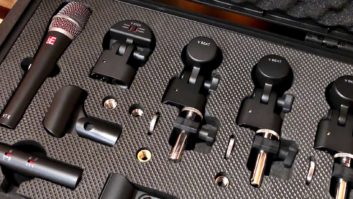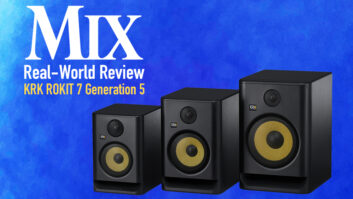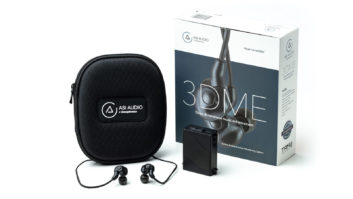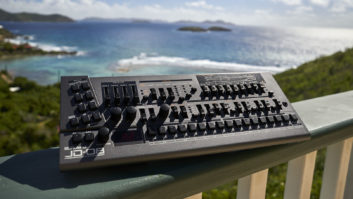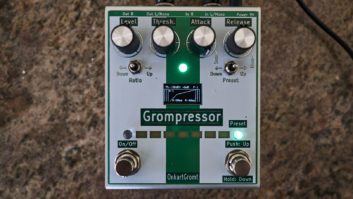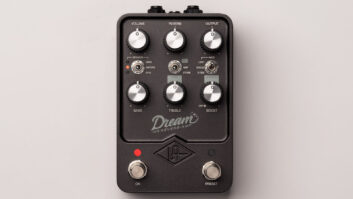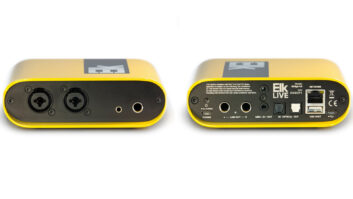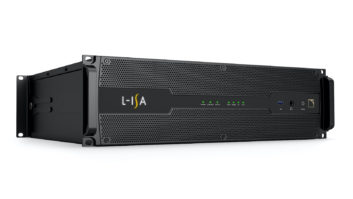French manufacturer Focal is widely recognized as a world leader in speaker technology, with a footprint that covers not only studio monitors, but audiophile speakers, car speakers and headphones. With that in mind, I’m quite aware that I’ve been the odd man out in my assessment of its popular SM9s, the flagship model prior to these Trio11 units. They are expertly built, high-quality monitors that get everything right, but have a frequency balance that somehow doesn’t work for me. I always thought it was the uniquely crisp tone of the beryllium tweeter, or perhaps the crossover to the tweet; it’s hard to find the words to explain it, and truthfully, I never could find an explanation.
Now I’ve had plenty of time with Focal’s new flagship studio monitor, the Trio11 Be, and I’ve completely reversed my opinion. These are the best-sounding monitors I’ve ever heard in my room, and they defied my biased expectations in a number of ways.
Out of the Box
The aesthetics and design of the Trio11s are familiar and an extension of Focal’s line, featuring 21 mm and 30 mm MDF cabinetry with Focal’s trademark dark red burr ash veneer finish, rigid “W” composite sandwich cones on the 5 1/8-inch woofer and 10-inch subwoofer (they’re not called midrange and woofer due to the Trio11’s 2-way or 3-way modes), a faux granite look on the woofer(s) cones, and the very same 1-inch pure beryllium inverted dome tweeter as in the SM9s.
A circular plate and enclosure mounts the small woofer and tweeter. This plate can rotate a full 360 degrees in 90-degree increments to accommodate vertical or horizontal mounting. The small woofer is ported, greatly contributing to accuracy and fidelity, according to Focal.
Three internal amps drive the Trio11s, with 300 watts going to the large woofer, 150 to the small (both with class-G power) and 100 watts to the tweeter with class-AB power. This prevalence of power makes for high-headroom operation and high SPL—118 dB at about 1 meter.
Overall bandwidth is a wide 30 Hz to 40 kHz at +/-3 dB. This response is tailorable to your control room with onboard analog EQ (not DSP), with a low shelf at 250 Hz, a LMF bell at 160 (with a Q of 1.0) and a high shelf at 4.5 kHz.
In Session
When they arrived, I was extremely careful to not damage these big, beautiful monitors; I followed Focal’s unpacking instructions to a tee. I tried the Trio11s first in the control room of a friend who uses Focal’s Solo6 Be monitors. The Trio11 and Solo6 monitors have a somewhat similar tone and balance, clearly showing they’re from the same line, but the Trio11s offer a larger, more forceful and more complete presentation.
After trying them in my friend’s control room, I moved the Trio11s to my studio for additional testing—I was lucky my friend offered to help because each monitor weighs over 80 pounds, well beyond my ability to handle solo. We placed the monitors on my control furniture’s shelf, inserting a set of four IsoAcoustics ISO-Pucks under each monitor to isolate their considerable weight and energy from the furniture. I rather optimistically placed the Trio11s in the prime position, without any monitors nearby to muck up the soundstage with unnecessary diffraction, and got right back to work, knowing full well the transition from my very different-sounding usual Neumann KH310s would be a little difficult at first, but believing I’d adjust shortly.
More Real-World Reviews by Rob Tavaglione:
• Review: KEF LSX Monitors
• Review: Revive Audio Vintage Audio MSL-Mk2 Compressor
• Review: RME Babyface Pro Interface
My first impression was that these were definitely not SM9s; the high end seemed smoother and more understated, and the tweeter didn’t have the 10-12 kHz emphasis I remembered. The midrange balance seemed exceedingly neutral, lacking any emphasis, dips or hollowness, even as the lack of high-mid hype (which the KH310s provide a bit of) seemed unfamiliar. After bypassing my subwoofer, the bottom end was attention-grabbing in its own way in that it had a consistency and level of detail I wasn’t used to.
I decided I needed to break in not only the Trio11s but also my perception of them, so I let them run for a couple of days during studio cleanup/maintenance, as I ran down much of my recent workload through them. During this phase, I noticed the oddest thing: I was getting nice, even coverage all throughout my room, with good intelligibility of the mids/highs and even bass coverage that was mode- and null-free compared to my usual setup with subwoofer. I soon realized I was getting a little low-mid murkiness from my furniture, and highs were dampened a bit much (out of necessity in my residential basement studio), so I set the Trio11’s LMF for -2 dB and the high shelf for +1 dB, and that’s where they stayed for the duration of my review.
During this time, I was able to use the Trio11s on a wide variety of musical styles (punk rock, R&B, rap, bluegrass, rock, gospel and jazz) as I tracked, edited, mixed and mastered in my busy room. Once I got used to their frequency response, I started to notice other traits, like the completely unrestrained dynamics. The only time I’ve heard this much headroom is in a proper mastering room with Dunlavys: the Trio11’s ability to rise up and deliver crescendos is quite impressive. You don’t realize how much headroom you typically lack until you hear it delivered with ease. Okay, I managed to get the Trio11s to their operational limit, but only via an EDM track with ridiculous deep synth bass—the woofers had started to slightly distort and chatter as the power LED went from green to flashes of red. With normal program material, they go louder than you can stand, unlike the Trio6 Bes, which get respectfully loud, but not as loud as situations occasionally require.
Noise is not an issue with Trio11 monitors. Self-noise is seemingly non-existent, unlike many monitors that use DSP and get a little hissy or have inadequate power filtering. Port noise was also not noticeable, despite front panel-mounted porting and the large amount of air being pushed around by that large woofer. Focal says this design makes for better performance if mounted close to walls/boundaries and it is major aspect of the Trio11s fidelity.

Focal’s much-touted Focus Mode (engaged with a footswitch, not provided) is useful, but not as much as one might think. For the limited-bandwidth playback and the information it provides, I’d rather use Avantones/Auratones, with their full-range driver and lack of a crossover. The Trio11s sound great in Focus Mode and are only lacking bottom end, so they’re not informative enough for me. But the Focus Mode is great during long vocal editing sessions, where a midrange focus and a little rest from low frequency is quite welcome.
I was surprised by one aspect of working exclusively on Trio11s that I didn’t expect at all. I thought my clients would get excited about these large monitors on my meter bridge and get hyper-focused on them. On the contrary, once I explained what they were hearing, they settled in without further distraction. There wasn’t as much second-guessing of my mix moves; there was less dissent in the room and they seemed to be hearing better back on their couch. I think the Trio11s sounded so good that the client was able to take them for granted, and that’s a very good thing.
One other observation bears mentioning. My room’s ceiling is fairly low, just 8.5 feet, and I’m not able to achieve uniform dispersion even with the ample absorption, diffusion and bass trapping I employ. With the Trio11’s, I got more even dispersion, a wider sweet spot and much better results than with my KH310s, which have a tweeter waveguide designed for low-ceiling environs. Without such a waveguide, the Focal tweeter still managed to cover my room better, and (needless to say) the bass response was more consistent throughout the room than with my sub. The Trio11s are the only monitor I’ve heard in my room with enough bass response, headroom and power to loudly drive the big bottom that my rock, EDM and rap clients require.
The Final Mix
Indeed, $8K is a lot of cash for a pair of Trio11s, but to these ears, they sound as complete, full and accurate as my previous benchmarks—PMCs and ATCs—at a lower cost. No-compromise monitoring requires ample power, large drivers and clever design, which the Trio11 monitors deliver in spades. There may be a better monitor in this class, but I’ve never heard it. Fans of the SM9 (and Trio6 Be) would be wise to check out these Trio11s, because they impressed the hell out of me and I was not previously a fan.
Focal • www.focal.com
Rob Tavaglione owns and operates Charlotte’s Catalyst Recording and has been a longtime studio contributor. www.twitter.com/robtavaglione
